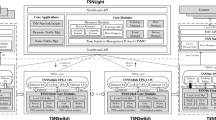Abstract
Networked control systems are subject to adversary conditions that affect their network topologies. To ensure reliable system operations, network topologies need to be characterized and managed for their impact on the overall system performance. This paper introduces the concept of network robustness depth for this pursuit. Discrete event systems are used as a foundation to model dynamic behavior of network topologies, support their analysis, and carry out their management. Stochastic analysis relates the link reliability probabilities to a probabilistic characterization of network robustness depth. Several topology management strategies are discussed, including passive methods, random strategies, and optimization methodologies. Their respective benefits and limitations are quantified. By using platoon control as a platform of hybrid (continuous and discrete event) systems and packet erasure channels as a communication protocol, the results are demonstrated with case studies.
Similar content being viewed by others
References
Lynch N A, Distributed Algorithms, Morgan Kaufmann Publishers, Inc., 1997.
Viseck T, Czirook A, Ben-Jacob E, Cohen O, and Shochet I, Novel type of phase transition in a system of self-driven particles, Physical Review Letters, 1995, 75(6): 1226–1229.
Wang L Y, Syed A, Yin G, Pandya A, and Zhang H W, Coordinated vehicle platoon control: Weighted and constrained consensus and communication network topologies, CDC 2012, Hawaii, Dec. 2012, 4057–4062.
Xiao L, Boyd S, and Kim S J, Distributed average consensus with least-mean-square deviation, Journal of Parallel and Distributed Computing, 2007, 67: 33–46.
Toner J and Tu Y, Flocks, herds, and schools: A quantitative theory of flocking, Physical Review E, 1998, 58(4): 4828–4858.
Wang L Y, Wang C, Yin G, and Wang Y, Weighted and constrained consensus for distributed power flow control, 12th International Conference on Probabilistic Methods Applied to Power Systems PMAPS 2012, Istanbul, Turkey, 2012.
Huang M and Manton J H, Coordination and consensus of networked agents with noisy measurements: Stochastic algorithms and asymptotic behavior, SIAM J. Control Optim., 2009, 48(1): 134–161.
Wang L and Liu Z, Robust consensus of multi-agent systems with noise, Science in China, Series F: Information Sciences, 2009, 52(5): 824–834.
Li T and Zhang J F, Consensus conditions of multi-agent systems with time-varying topologies and stochastic communication noises, IEEE Trans. on Automatic Control, 2010, 55(9): 2043–2057.
Bai F, Stancil D D, and Krishnan H, Toward understanding characteristics of dedicated short range communications (DSRC) from a perspective of vehicular network engineers, Proceedings of MobiCom 10, Chicargo, IL, USA, 2010, 329–340.
Yin G, Wang L Y, Sun D, Casbeer R H, and Kingston D, Asymptotic optimality for consensustype stochastic approximation algorithms using iterate averaging, Journal of Control Theory and Applications, 2013, 11(1): 1–9.
Yin G, Sun Y, and Wang L Y, Asymptotic properties of consensus-type algorithms for networked systems with regime-switching topologies, Automatica, 2011, 47: 1366–1378.
Yin G, Wang L Y, and Sun Y, Stochastic Recursive algorithms for networked systems with delay and random switching: Multiscale formulations and asymptotic properties, Multiscale Modeling & Simulation, 2011, 9(3): 1087–1112.
Bollobás B, Random Graphs, 2nd Edition, Cambridge University Press, 2001.
Cassandras C G and Lafortune S, Introduction to Discrete Event Systems, 2nd Edition, Springer, 2008.
Lafortune S and Lin F, On tolerable and desirable behaviors in supervisory control of discrete event systems, Discrete Event Dynamic Systems: Theory and Applications, 1990, 1(1): 61–92.
Li Y, Lin F, and Lin Z H, Supervisory control of probabilistic discrete event systems with recovery, IEEE Transactions on Automatic Control, 1999, 44(10): 1971–1974.
Brualdi R A and Ryser H J, Combinatorial Matrix Theory, Cambridge University Press, 1991.
Godsil C and Royle G, Algebraic Graph Theory, Springer-Verlag, New York, 2001.
Reingold O, Undirected connectivity in log-space, Journal of the ACM, 2008, 55(4): 1–20.
Lapidoth A, The performance of convolutional codes on the block erasure channel using various finite interleaving techniques, IEEE Trans. on Inform. Theory, 1994, 40(5): 1459–1473.
Knopp R and Humblet P, On coding for block fading channels, IEEE Trans. on Inform. Theory, 1999, 46(1): 1643–1646.
Guillen A, Fabregas I, and Caire G, Coded modulation in the blockfading channel: Code construction and coding theorems, IEEE Trans. on Inform. Theory, 2006, 52(1): 91–114.
Author information
Authors and Affiliations
Corresponding author
Additional information
This research was supported in part by the National Science Foundation under Grant No. CPS-1136007.
This paper was recommended for publication by Editor XIE Liangliang.
Rights and permissions
About this article
Cite this article
Wang, L., Lin, F. & Yin, G. Network robustness depth and topology management of networked dynamic systems. J Syst Sci Complex 29, 1–21 (2016). https://doi.org/10.1007/s11424-015-4074-4
Received:
Revised:
Published:
Issue Date:
DOI: https://doi.org/10.1007/s11424-015-4074-4




